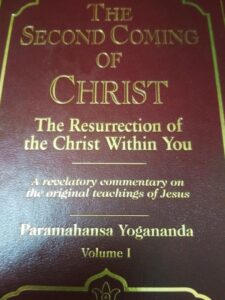“The best is the enemy of the good” so said Voltaire.
I know of few positions that men take that sound more reasonable, seem more balanced, appear more rational and look more broadminded than the popular belief:
“On the surface various religions may look different and some of them may make special claims, but when you go deep it becomes apparent that they are all alike and are just parallel paths to God.”
This position can also be very wrong!
Great is the number of men and women that have been lulled into a sense of false security by this copacetic statement, thereby missing the best that they may have otherwise attained.
It is neither necessary nor warranted to go searching for harmony where there is none; to look for the middle ground; to reduce everything to the lowest common denominator.
This is where (in my view) Mahāvatār Bābājī , Yogiraj Lahiri Mahasaya, Swami Shri Yukteswar et al found it so difficult to take a stand for Christ, even though by their own admission they knew the Truth (Jesus Christ, see article 3 in this series ) and communed with him. Moreover they enjoined their disciples to follow the same equivocal course as they did and propagate a confounded message which bade fair to bulldoze legitimate challenges and run all steams of faith into one accommodative river putatively headed to the ocean of God consciousness.
Paramahansa Yogananda was no exception.
It has been our endeavour in the last two articles to show the difficulty he encountered in portraying harmony between Christ and Krishna though his intent was sincere and his efforts genuine. Though I do not doubt his claim that he communed with Christ several times, to my mind it would have made a world of difference if only he had taken time to station himself at the foot of the cross where the sinless saviour of mankind was crucified and shed his precious blood.
(In all fairness, I do not rule out the possibility of jumping the gun myself; perhaps I am still scratching at the surface of PY’s book)
It was Rev. Sunder Krishnan, pastor at the Rexdale Alliance church (Toronto) for 36 years who stood this popular belief (quoted near the top) upside down. He said (something like):
“Christianity might appear the same on the outside like other religions, but when you go deep you discover that it is unique.”
When I add a piece of information that he is a graduate of the Indian Institute of Technology, New Delhi and received his M.S. in Mechanical Engineering from the Massachusetts Institute of Technology and worked with Atomic Energy of Canada, you should weigh him differently from your average North American pastor. Not that one should be an intellectual heavy weight to understand momentous truths, but it helps. Let me quote the Bible in support: “a Pharisee named Gamaliel, a teacher of the law, who was honored by all the people” (Acts 5:34) Apostle Paul saying after his conversion: ““I am a Jew, born in Tarsus in Cilicia, but brought up in this city, educated at the feet of Gamaliel”(Acts 22:3). Yes, Gamaliel was a Doctor of Law and this facts lends credibility to Paul’s conversion story!
Also, retention of “Krishnan” in his name tells you that he knows what he is talking about. Chances are that he wasn’t forcibly converted!! Though like Paramahansa Yogananda, he too traveled to North America, he too was likely grounded in both Hinduism – his birth religion – and the teachings of Jesus Christ whom he later embraced, he was so very clear and pointed about the Truth he discovered that he did not feel the need to do any balancing act between the two religions and argue that they were essentially the one and the same. Like PY, he too authored many books and Bible Studies including one entitled “Consider Jesus“.
While PY seemed to be labouring under the weight of a heavy obligation placed on him by his gurus and seems to be contorting himself in an effort to pay equal obeisance to Christ and Krishna – sometimes contrary to his deepest convictions (in my reading) – Sunder seems to be liberated, with God “shining in his heart to give the light of the knowledge of the glory of God in the face of Jesus Christ“(2 Cor. 4:6).
Why do I make bold to utter a statement like that? Apart from
I also came across another book by PY shown below and I found its opening lines revealing:
Quote:
The characteristic features of Indian culture have long been a search for ultimate verities and the concomitant disciple-guru relationship. My own path led me to a Christlike sage whose beautiful life was chiseled for the ages.
Unquote
A yogi like PY thoroughly instructed in the Hindu tradition and teachings of various gods and their disciples, rishis, munis and other saintly men (and women) no doubt had a galaxy of deities and holy figures to invoke for comparison to his guru, and yet, who does he choose:
Jesus Christ!!
____________________________________


